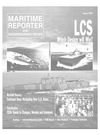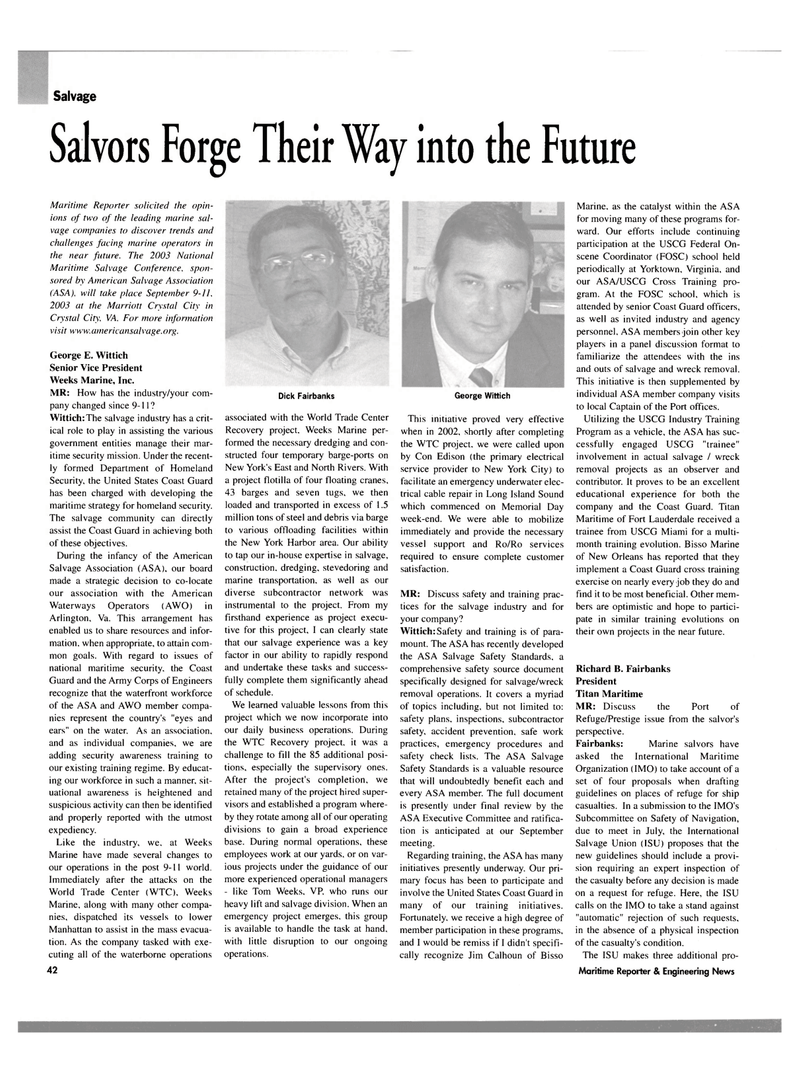
Page 42: of Maritime Reporter Magazine (August 2003)
Read this page in Pdf, Flash or Html5 edition of August 2003 Maritime Reporter Magazine
Salvage
Salvors Forge Their Way into the Future
Maritime Reporter solicited the opin- ions of two of the leading marine sal- vage companies to discover trends and challenges facing marine operators in the near future. The 2003 National
Maritime Salvage Conference, spon- sored by American Salvage Association (ASA), will take place September 9-11, 2003 at the Marriott Crystal City in
Crystal City, VA. For more information visit www.ainericansalvage.org.
George E. Wittich
Senior Vice President
Weeks Marine, Inc.
MR: How has the industry/your com- pany changed since 9-11?
Wittich:The salvage industry has a crit- ical role to play in assisting the various government entities manage their mar- itime security mission. Under the recent- ly formed Department of Homeland
Security, the United States Coast Guard has been charged with developing the maritime strategy for homeland security.
The salvage community can directly assist the Coast Guard in achieving both of these objectives.
During the infancy of the American
Salvage Association (ASA), our board made a strategic decision to co-locate our association with the American
Waterways Operators (AWO) in
Arlington, Va. This arrangement has enabled us to share resources and infor- mation. when appropriate, to attain com- mon goals. With regard to issues of national maritime security, the Coast
Guard and the Army Corps of Engineers recognize that the waterfront workforce of the ASA and AWO member compa- nies represent the country's "eyes and ears" on the water. As an association, and as individual companies, we are adding security awareness training to our existing training regime. By educat- ing our workforce in such a manner, sit- uational awareness is heightened and suspicious activity can then be identified and properly reported with the utmost expediency.
Like the industry, we. at Weeks
Marine have made several changes to our operations in the post 9-11 world.
Immediately after the attacks on the
World Trade Center (WTC), Weeks
Marine, along with many other compa- nies, dispatched its vessels to lower
Manhattan to assist in the mass evacua- tion. As the company tasked with exe- cuting all of the waterborne operations 42
Dick Fairbanks associated with the World Trade Center
Recovery project. Weeks Marine per- formed the necessary dredging and con- structed four temporary barge-ports on
New York's East and North Rivers. With a project flotilla of four floating cranes, 43 barges and seven tugs, we then loaded and transported in excess of 1.5 million tons of steel and debris via barge to various offloading facilities within the New York Harbor area. Our ability to tap our in-house expertise in salvage, construction, dredging, stevedoring and marine transportation, as well as our diverse subcontractor network was instrumental to the project. From my firsthand experience as project execu- tive for this project. I can clearly state that our salvage experience was a key factor in our ability to rapidly respond and undertake these tasks and success- fully complete them significantly ahead of schedule.
We learned valuable lessons from this project which we now incorporate into our daily business operations. During the WTC Recovery project, it was a challenge to fill the 85 additional posi- tions, especially the supervisory ones.
After the project's completion, we retained many of the project hired super- visors and established a program where- by they rotate among all of our operating divisions to gain a broad experience base. During normal operations, these employees work at our yards, or on var- ious projects under the guidance of our more experienced operational managers - like Tom Weeks, VP. who runs our heavy lift and salvage division. When an emergency project emerges, this group is available to handle the task at hand, with little disruption to our ongoing operations.
George Wittich
This initiative proved very effective when in 2002, shortly after completing the WTC project, we were called upon by Con Edison (the primary electrical service provider to New York City) to facilitate an emergency underwater elec- trical cable repair in Long Island Sound which commenced on Memorial Day week-end. We were able to mobilize immediately and provide the necessary vessel support and Ro/Ro services required to ensure complete customer satisfaction.
MR: Discuss safety and training prac- tices for the salvage industry and for your company?
Wittich:Safety and training is of para- mount. The ASA has recently developed the ASA Salvage Safety Standards, a comprehensive safety source document specifically designed for salvage/wreck removal operations. It covers a myriad of topics including, but not limited to: safety plans, inspections, subcontractor safety, accident prevention, safe work practices, emergency procedures and safety check lists. The ASA Salvage
Safety Standards is a valuable resource that will undoubtedly benefit each and every ASA member. The full document is presently under final review by the
ASA Executive Committee and ratifica- tion is anticipated at our September meeting.
Regarding training, the ASA has many initiatives presently underway. Our pri- mary focus has been to participate and involve the United States Coast Guard in many of our training initiatives.
Fortunately, we receive a high degree of member participation in these programs, and I would be remiss if I didn't specifi- cally recognize Jim Calhoun of Bisso
Marine, as the catalyst within the ASA for moving many of these programs for- ward. Our efforts include continuing participation at the USCG Federal On- scene Coordinator (FOSC) school held periodically at Yorktown, Virginia, and our ASA/USCG Cross Training pro- gram. At the FOSC school, which is attended by senior Coast Guard officers, as well as invited industry and agency personnel. ASA members join other key players in a panel discussion format to familiarize the attendees with the ins and outs of salvage and wreck removal.
This initiative is then supplemented by individual ASA member company visits to local Captain of the Port offices.
Utilizing the USCG Industry Training
Program as a vehicle, the ASA has suc- cessfully engaged USCG "trainee" involvement in actual salvage / wreck removal projects as an observer and contributor. It proves to be an excellent educational experience for both the company and the Coast Guard. Titan
Maritime of Fort Lauderdale received a trainee from USCG Miami for a multi- month training evolution. Bisso Marine of New Orleans has reported that they implement a Coast Guard cross training exercise on nearly every job they do and find it to be most beneficial. Other mem- bers are optimistic and hope to partici- pate in similar training evolutions on their own projects in the near future.
Richard B. Fairbanks
President
Titan Maritime
MR: Discuss the Port of
Refuge/Prestige issue from the salvor's perspective.
Fairbanks: Marine salvors have asked the International Maritime
Organization (IMO) to take account of a set of four proposals when drafting guidelines on places of refuge for ship casualties. In a submission to the IMO's
Subcommittee on Safety of Navigation, due to meet in July, the International
Salvage Union (1SU) proposes that the new guidelines should include a provi- sion requiring an expert inspection of the casualty before any decision is made on a request for refuge. Here, the ISU calls on the IMO to take a stand against "automatic" rejection of such requests, in the absence of a physical inspection of the casualty's condition.
The ISU makes three additional pro-
Maritime Reporter & Engineering News

 41
41

 43
43
